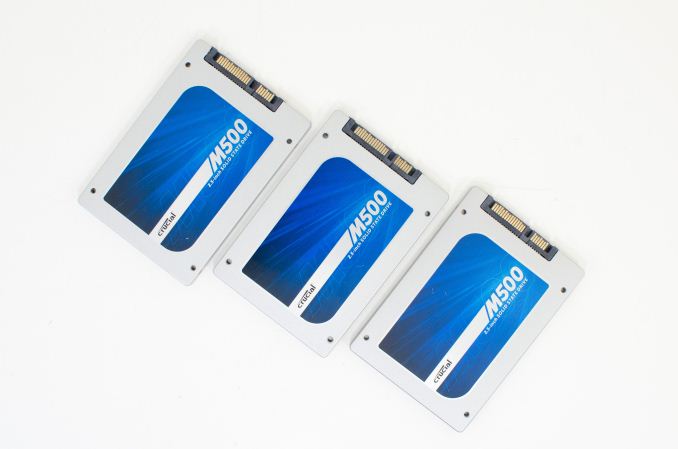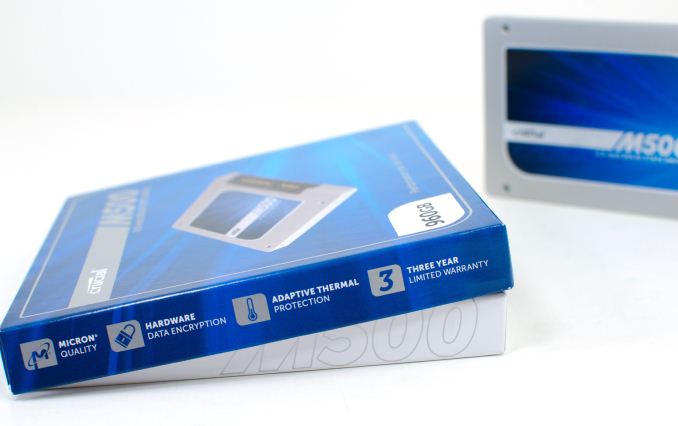The Crucial/Micron M500 Review (960GB, 480GB, 240GB, 120GB)
by Anand Lal Shimpi on April 9, 2013 9:59 AM ESTFinal Words
For SSDs to become more cost effective they need to implement higher density NAND, which is often at odds with performance, endurance or both. Samsung chose the endurance side of the equation, but kept performance largely intact with the vanilla 840. Given that most client workloads aren't write heavy, the tradeoff made a lot of sense. With the M500, Crucial came at the problem from the performance angle. Keep endurance the same, but sacrifice performance in order to hit the right cost target. In the long run I suspect it'll need to be a combination of both approaches, but for now that leaves us in a unique position with the M500.
The M500's performance is by no means bad, but it's definitely slower than the competition. Crucial targeted Samsung's SSD 840, but in most cases the TLC based 840 is faster than the M500. There's probably some room for improvement in the M500's firmware, but there's no escaping the fact that read, program and erase latencies are all higher as a result of the move to larger pages/blocks with the drive's 128Gbit NAND die. The benefit to all of this should be cost, but we'll have to wait and see just how competitive the smaller capacities of the M500 are on cost.
The saving grace when it comes to the M500's performance, at least compared to Samsung's offerings, is worst case IO consistency in a full drive state. If you have the luxury of keeping around 20% of your drive free, Samsung maintains its performance advantage. If, on the other hand, you plan on using almost all of your drive's capacity - the M500 does have better behavior than even the 840 Pro. It's an interesting tradeoff, but going forward I feel like we're going to have to start distinguishing between both usage models. The M500 definitely isn't the best when it comes to delivering both high performance and consistent IO, that title continues to belong to Corsair with its Link_A_Media based Neutron drive. But among the current crop of non-SandForce tier 1 SSD manufacturers, the M500 does reasonably well.
The encryption story on the M500 is potentially very interesting. Assuming the drive is indeed fully supported as a Windows 8 eDrive like Crucial claims, the M500 would be the obvious choice for anyone who had to run with BitLocker enabled. The prospect of seeing more SSDs with hardware encryption that can be leveraged by the OS is downright exciting. Honestly I wasn't aware of the eDrive spec until testing the M500, but now I want to see something similar from Apple as well.
Power consumption is another potentially good story from Crucial, assuming idle power in a notebook is truly as low as it claims. Power under load is competitive with Samsung's SSD 840 Pro, and actually even lower than the vanilla 840. Given that neither of those drives is particularly power hungry, the M500 does well there. Support for DevSleep is a nice addition. The combination of the M500's encryption support and DevSleep give us a good idea of two platform features that we should hope to see from all modern drives during this next generation.
All of this brings us to recommendation time. The easiest of the M500 drives to recommend and dismiss are the highest and lowest capacity versions, respectively. The 960GB M500 is the cheapest 1TB-class SSD I've seen to date, and it's likely the best buy if you need that much storage in a single drive. Performance still falls short of the fastest drives in this space, but if you need the capacity and plan on using all of it the M500 is really the only game in town. I've been hammering on the 960GB very hard over the past few days and while it hasn't been long enough to clear the drive as reliable, so far it's handled everything I've thrown at it very well (including our new Destroyer benchmark). I know I've personally been waiting for a good, high-capacity SSD for notebook use and based on my options today, I'd have no issues going with the 960GB M500.
On the other side of the fence, the 120GB version sacrifices a lot of performance as a result of only using a total of 8 NAND die within the drive. Unless its street price is significantly more attractive than its MSRP, I don't see a reason to choose the 120GB M500.
Recommending the two middle capacities (240/480GB) will really depend on street pricing. Based on their MSRPs, the M500 doesn't appear to be any more competitive here. I suspect that we will see closer-to-840 pricing after a few weeks of being in the channel, at which point they may be worth another look. For now, we play the waiting game.












111 Comments
View All Comments
philipma1957 - Thursday, April 18, 2013 - link
it is all about how much you want to pay. if you buy 1 960gb micron ssds and buy a pegasus r4. with 41tb hdds you can get a very fast booting mac setup. cost is 600 + 999 or 1600. pull one 1tb hdd from the pegasus and put in the micron 960gb ssd. you have a 1tb ssd as your boot drive and 3 x 1tb hdds for storage along with a 1tb hdd as a spare.. but that is a 1600 solution pretty high costUmika - Monday, April 22, 2013 - link
I have now one of these M500 SSDs and I have actually managed to lock me out of the drive using 3rd party OPAL TCG software. Now the printed PSID comes into play: I have downloaded the Seagate SeaTools utilities for Windows to try to crypto erase the SSD, but to no avail - the SeaTools always terminate with an error message. Is there any other openly available software to try to erase or PSID revert the drive to factory settings?gzon - Tuesday, April 23, 2013 - link
I am also experiencing problems with the OPAL encryption. Windows 8 does not seem to revert the disk back to manufactured-inactive state. Also tried PSID revert with SeaTools but it did not work. Where can I find software to PSID revert the disk?mikato - Tuesday, April 23, 2013 - link
"the key is just stored in the controller and everything is encrypted/decrypted on the fly"What happens if the controller breaks somehow and you need data recovery? You're just screwed? Of course backing up is the best way to go but we all know not many people do that and with these large SSD sizes they'll be taking on more data and not just an OS and programs that can always be reinstalled.
odedia - Sunday, July 21, 2013 - link
I can just drool over the thought of putting two of these in my 17 inch Macbook Pro. I currently have a 128gb Intel SSD and a 500gb spinning drive. This will be a serious upgrade, and I'll be able to RAID0 them together for better performance and easier drive management.littlesandra88 - Tuesday, August 27, 2013 - link
How can an ATA BIOS password not be secure, if it changes the password (makes a new hash)?paaraa - Friday, November 29, 2013 - link
People always keep hammering about the Samsung SSD's, but did you know about the bad block issue they have? Look up the 'SSD Endurnce Experiment' (the 200TB update) at Tech Report and you will see the bad block tally of the Samsung being way up there.New Egg current (black friday) has the 480gb M500 on sale for $279, pretty good. I have two M4's (128gb) and they have been great for years now.
Gallopsu - Monday, December 23, 2013 - link
This article mentions increased performance by 25% over provisiong. Is this something that must be configured in the bios or firmware. Or is it accomplished by simply not filling it to capacity. Or should only format it to 768GB and leave the rest untouched? How can I confirm that it is actually working? Would hate to give up that space and not get the benefits.clifforama - Tuesday, January 21, 2014 - link
Have you had any response from Crucial regarding how to perform a PSID reset/revert?bogdan_kr - Thursday, January 23, 2014 - link
Yes, I would like to know that too. Crucial has not provided any information on their forums but I guess they could possibly send some more specific information to you Anand :-)